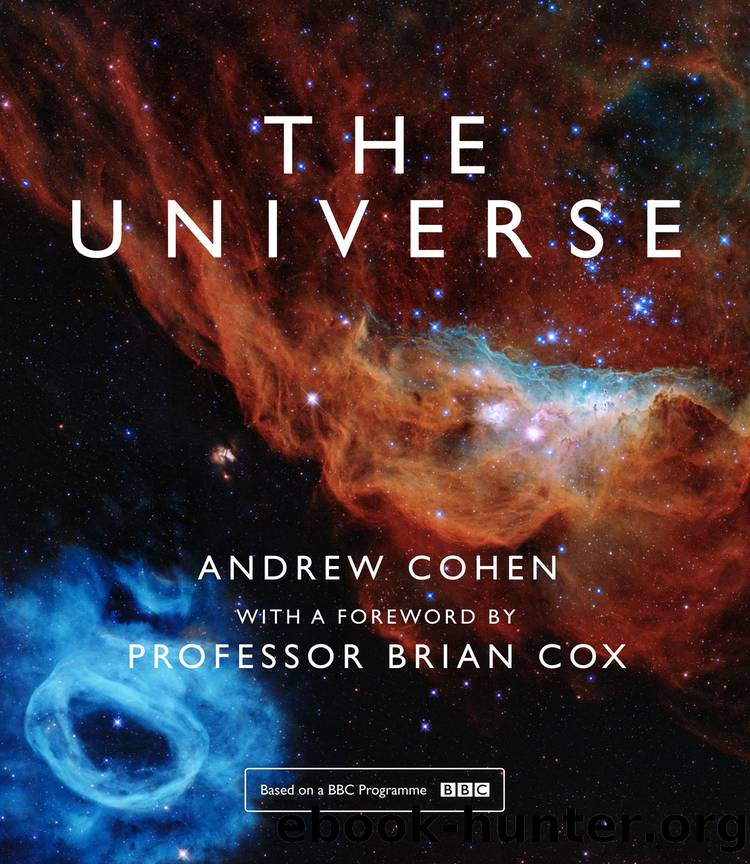The Universe by Andrew Cohen

Author:Andrew Cohen
Language: eng
Format: epub
Publisher: HarperCollins Publishers
Light emanating from polarised dust. The texture indicates the galactic magnetic field lines.
The towers of fiery colours in Planckâs map of the Milky Way are dust particles that have been polarised by reflected light.
Created from Gaiaâs data, this map shows the trails of 40,000 stars as they will move across the sky for the next 400,000 years.
This collection of images illustrates the remarkable variety of intricate structures that can form when galaxies collide.
Gaia-Enceladus collision
Galaxies colliding is a very interesting process; it might sound like a very destructive sequence of events, but if you actually run a cosmological simulation of two galaxies colliding, itâs really quite beautiful and actually a pretty formative event. The way in which the mutual gravity of these two galaxies interacts with each other causes one to start spiralling around the other, before it comes back. Itâs like two objects performing a sort of celestial ballet around each other, until eventually one day friction is able to bring the smaller of the two objects crashing in towards the centre of the galaxy.
When galaxies interact with one another and collide, what typically happens is that you actually get a big burst of star formation occurring, because you are essentially bringing a new source of star-forming fuel into the Milky Way. In terms of Gaia-Enceladus, it brought in with it its gaseous content, then as it fell in and plunged into the Milky Way, this gaseous content gets compressed and actually has high-enough densities that are needed to start the formation of new stars. But this process can also lead to disturbances in the existing configuration of stars in the Milky Way. So, for example, if a galaxy plunging into the Milky Way gets close enough to the disc, you can actually start creating warps in the distribution of stars and oscillations in the motions of stars in or around the disc. Which means both events really donât go completely unnoticed.
The Milky Way has experienced a large number of these kinds of emerging events, with Gaia-Enceladus being one example, and one of the big implications of this is that there is a sizeable fraction of the stars in our Milky Way that were actually not part of the system originally, that came in from a neighbouring galaxy. So, the stellar content that we see around us today is really the sum total of intrinsic star formation within the Milky Way, but also the donations from all of the other neighbouring galaxies that came in. Thus, each of these stars actually maintain, in a weird sort of way, a fingerprint relating to their origins, which helps us decode the kinds of events that the Milky Way underwent in its past.
Sownak Bose, Researcher, Center for Astrophysics, Harvard
Download
This site does not store any files on its server. We only index and link to content provided by other sites. Please contact the content providers to delete copyright contents if any and email us, we'll remove relevant links or contents immediately.
Turbulence by E. J. Noyes(7031)
Tools of Titans by Timothy Ferriss(6934)
Astrophysics for People in a Hurry by Neil DeGrasse Tyson(4613)
Room 212 by Kate Stewart(4099)
Pale Blue Dot by Carl Sagan(3995)
The David Icke Guide to the Global Conspiracy (and how to end it) by David Icke(3875)
Secrets of Antigravity Propulsion: Tesla, UFOs, and Classified Aerospace Technology by Ph.D. Paul A. Laviolette(3430)
Apollo 8 by Jeffrey Kluger(3196)
Losing the Nobel Prize by Brian Keating(3184)
A Journey Through Divination and Astronomy by Publishing Pottermore(3026)
Goodbye Paradise(2949)
COSMOS by Carl Sagan(2944)
Brief Answers to the Big Questions by Stephen Hawking(2872)
How to Read Water: Clues and Patterns from Puddles to the Sea (Natural Navigation) by Tristan Gooley(2849)
The Five People You Meet in Heaven by Mitch Albom(2834)
The Order of Time by Carlo Rovelli(2708)
How to Read Nature by Tristan Gooley(2657)
A Brief History of Time by Stephen Hawking(2470)
Aliens by Jim Al-Khalili(2376)
